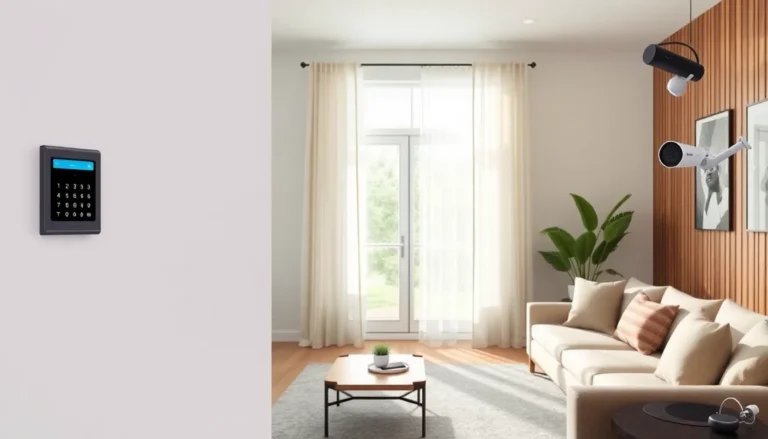Home renovations can feel like a wild rollercoaster ride—exciting yet terrifying. One moment, you’re envisioning your dream kitchen, and the next, you’re knee-deep in paint swatches and power tools, wondering why you thought this was a good idea. But fear not! With a little organization, you can turn that chaos into a symphony of home improvement.
Table of Contents
ToggleUnderstanding Home Renovations
Home renovations require careful consideration and comprehensive planning. By grasping the essential elements, individuals can navigate the complexities involved effectively.
Importance of Planning
Planning plays a pivotal role in achieving a successful renovation. It enables individuals to outline goals, establish budgets, and set timelines. Proper planning prevents unexpected costs and delays, ensuring that the project stays on track. Understanding specifics helps prioritize tasks, such as obtaining necessary permits and hiring qualified professionals. Clear arrangements for materials and schedules reduce confusion, making the process smoother. Dedicating time to this phase significantly enhances overall project management.
Common Home Renovation Projects
Homeowners frequently engage in various renovation projects. Kitchen remodels often top the list, enhancing both functionality and aesthetics. Bathroom upgrades follow closely, providing modern amenities and improved comfort. Expanding living spaces, such as finished basements or added decks, increases property value significantly. Additionally, exterior renovations, like siding replacements or landscaping improvements, contribute to curb appeal. Each project requires tailored planning to address specific needs and goals. Understanding these common types can streamline decision-making and elevate satisfaction with the final results.
Steps to Organize Home Renovations

Organizing home renovations requires strategic planning and attention to detail. Following specific steps leads to smoother projects and better outcomes.
Create a Renovation Checklist
A renovation checklist serves as a foundational tool. It consolidates essential tasks, such as selecting contractors and scheduling inspections. Prioritize tasks by urgency; for instance, securing permits often comes first. Include design decisions, like colors and materials, to streamline choices. Collaborate with family members or housemates to gather input and ensure everyone’s preferences are addressed. Update the checklist regularly to reflect completed tasks and new additions. This structured approach reduces oversight and enhances clarity throughout the renovation process.
Set a Realistic Budget
Setting a realistic budget is crucial for a successful renovation. Begin by estimating overall costs based on project scopes, such as kitchen or bathroom remodels. Break down expenses into categories, including materials, labor, and unexpected costs. Allocate at least 10-20% of the budget for contingencies, preparing for unforeseen expenses that often arise during renovations. Research local market prices for materials and services to refine budget accuracy. Track spending against the budget through spreadsheets or apps, ensuring financial control during the project. Communicate with contractors about budget concerns; transparency fosters trust and can lead to cost-effective adjustments.
Choosing the Right Professionals
Choosing the right professionals significantly impacts the success of home renovations. Properly selected experts streamline the process and enhance final results.
Hiring Contractors
Hiring contractors involves careful vetting to ensure quality workmanship. Start by seeking recommendations from trusted sources. Verify credentials, licenses, and insurance coverage to ensure reliability. Conduct interviews with potential contractors, discussing project timelines and previous experiences. Request detailed estimates and check reviews from prior clients. Finalize contracts that outline scope, timeline, and payment terms. Establish clear communication channels to monitor progress, address any concerns, and maintain project integrity.
Working with Designers
Working with designers enhances creativity and functionality in renovations. Identify designers whose styles align with personal visions. Review portfolios to evaluate their previous work and gather inspiration. Share renovation goals, preferences, and budgets early on to ensure alignment. Collaborate closely, providing feedback throughout the design process. Stay open to suggestions, allowing for innovative solutions. By fostering a strong partnership, homeowners achieve a more cohesive and visually appealing final result that surpasses initial expectations.
Managing the Renovation Process
Effective management of the renovation process involves meticulous planning and open communication. Homeowners benefit from understanding timelines and establishing clear lines of dialogue with contractors.
Timeline for Renovations
Creating a realistic timeline is vital in managing home renovations. Start by breaking the project into phases, which makes it easier to estimate the time required for each segment. Consider factors like permitting, weather conditions, and delivery times for materials. Keeping a flexible approach allows for adjustments when unforeseen delays occur. For instance, kitchen remodels might need longer timelines due to intricate designs or custom cabinetry. Use milestone markers to track progress and stay on schedule, ensuring the project runs smoothly from start to finish.
Communication with Contractors
Establishing strong communication with contractors leads to better outcomes. Schedule regular check-ins to discuss progress and address concerns promptly. Transparency fosters trust, so share renovation goals and budget constraints openly. Homeowners should ask for updates on changes to timelines or budgets to stay informed. Provide feedback and express preferences clearly, enabling contractors to align their work with the homeowner’s vision. Utilizing tools like messaging apps or project management software can enhance collaboration, keeping everyone engaged and accountable throughout the renovation journey.
Post-Renovation Tips
Homeowners can maximize the benefits of renovations with a few essential post-renovation steps. Implementing these tips ensures satisfaction with the completed project.
Final Inspections
Conducting thorough final inspections is crucial to assess the quality of work completed. Evaluating each room for functionality and aesthetics uncovers any issues needing attention. Professionals should address discrepancies with the contractors promptly, ensuring everything aligns with initial agreements. Documenting findings will benefit future reference and warranty claims. Taking time for these reviews prevents unexpected issues from arising later, providing peace of mind.
Maintaining Your Renovated Space
Maintaining renovated spaces is vital for long-term satisfaction. Establishing a regular cleaning routine preserves the freshness of finishes and fixtures. Implementing preventative measures extends the longevity of materials used during the renovation. Scheduling seasonal checks for systems like plumbing and electrical ensures continued functionality and safety. Creating a log of maintenance tasks helps keep track of necessary upkeep, promoting a beautiful and functional home for years to come.
Successfully organizing home renovations transforms a daunting task into a rewarding journey. By following a structured approach homeowners can navigate the complexities of their projects with confidence. Prioritizing clear communication with contractors and family members ensures everyone’s vision is aligned and expectations are met.
Establishing a realistic budget and timeline helps prevent unexpected surprises while fostering a sense of control over the renovation process. With the right planning and professional support homeowners can create spaces that not only reflect their style but also enhance their daily lives. Embracing the renovation experience ultimately leads to a home that’s both functional and beautiful.



